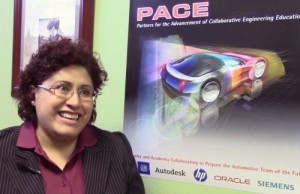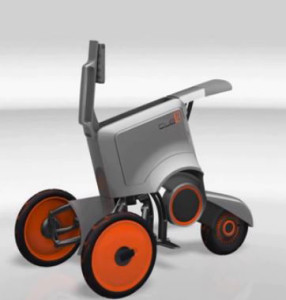
Date: 06/16/2014
Writer: Emilee Cantrell, (575) 646-2913, [email protected]
In July, engineering students from New Mexico State University will travel to Turin, Italy, having earned a spot in the second phase of a two-year global collaboration project involving institutions in 11 countries. The team designed and fabricated a mobile device for individual transportation within urban settings and will compete against their peers in the Portable Assisted Mobile Device vehicle competition.
The competition is sponsored by PACE (Partners for the Advancement of Collaborative Engineering Education), an organization that links GM, Autodesk, Hewlett-Packard, Siemens PLM Software, Sun Microsystems, and their global operations, to support strategically selected academic institutions worldwide to develop the automotive product lifecycle management team of the future.

Patricia Sullivan, assistant dean for the College of Engineering, is the PACE integrator at NMSU. She said the PACE partnership provides a unique opportunity for student-industry collaboration in the design and manufacturing process.
In July 2013, seven teams from 32 universities presented their design concepts for the PAMD competition in Pasadena, California. NMSU was part of one of the teams selected to advance to the next phase of the competition.
NMSU is a member of a team composed of students from the University of Sao Paulo in Brazil, Jilin University of China, the Art Center College of Design in Pasadena, the Instituto Politecnico Nacional in Mexico and Hochschule RheinMain University in Germany.
This phase of the PAMD competition focuses on advanced manufacturing concepts – the quick transfer of science and technology into manufactured products and processes. The goal is to teach students how to take a project from initial design concept to full-scale manufacturing including design of the proposed manufacturing facility. Each team is required to meet specified weight, size and functional parameters. Other aspects of manufacturing considered in the project include ergonomics, comfort of the product, build of materials required for manufacturing and the potential market for the product.
Delia J. Valles-Rosales, associate professor of industrial engineering, is overseeing the project at NMSU and works with students in designing and planning the facility where the device will be manufactured.
NMSU’s role includes the manufacturing of several parts of the device, the business plan, device design and large-scale manufacturing facility planning. Valles said the students will also complete marketing analysis, research, design and prototype development and the assembly and mass production of the device.
Brendan P. Sullivan, PACE project lead at NMSU, said one of the challenges the team encountered was bringing together a large group of people with different levels of expertise; design changes from the NMSU team as well as those of their partner international teams had to be considered.
The interdisciplinary aspects of the PACE project allow for a truly cooperative team, Sullivan said. Should a problem arise, working cooperatively to address different areas of the project allows for easier integration of change. The major learning comes from getting familiarized with other individuals, contacts and application of project management skills.
“As part of the competition, we use the same software General Motors and Siemens use, so we are not only aware of any difficulties those companies may encounter, but how industry operates,” Sullivan said.
Sullivan said good facility design is essential to manufacturing a product. The PACE project required the facilities team to create a comprehensive build of materials for actual production. The project required additional consideration of regulatory constraints and safety protocols.
Ken Ruble, operations manager of the College of Engineering Aggie Innovation Space, has been advising the team making sure that deadlines are met and designs are validated. Many of the components for the construction of the prototype have been designed and created using 3-D printers in the Aggie Innovation Space, a new facility for innovation and entrepreneurship within the college made possible through a partnership with Intel.
Valles said the initial prototype device is being designed for use in Brazil where mass transportation is widely used. This device would provide an alternative and convenient mode of limited distance transportation in an urban setting.
“The students involved in this project not only collaborate and meet people from other universities across the U.S. and abroad, but also develop invaluable engineering and team-building skills,” Valles said.
Colt Capurro, mechanical engineering senior, PACE manufacturing team lead and member of the NMSU Rodeo team, said he has learned to apply his classroom knowledge of the engineering design process during his involvement in this project.
“You can’t just design and go directly to manufacturing; there are many steps to the design process that have to be validated and tested,” he said, adding that the PACE project gives students real-world experience.
Capurro said there are plans to make the device more customizable, such as different color schemes, different motors, faster models, more storage space, and smaller or compact models. The device was designed to be foldable, lightweight, and easy to carry. The PAMD was also designed to use a charging station similar to those used for electric cars.
NMSU College of Engineering student team members traveling to the PACE competition in Turin, Italy this summer include Sullivan, Capurro, Oscar Torres and Mauricio Garcia. General Motors plans to manufacture the winning device beginning in 2016.
Watch the video on YouTube at https://www.youtube.com/watch?v=2nFLGBTPyvQ&feature=youtu.be.
For more information on this, and other NMSU stories, visit the NMSU News Center.